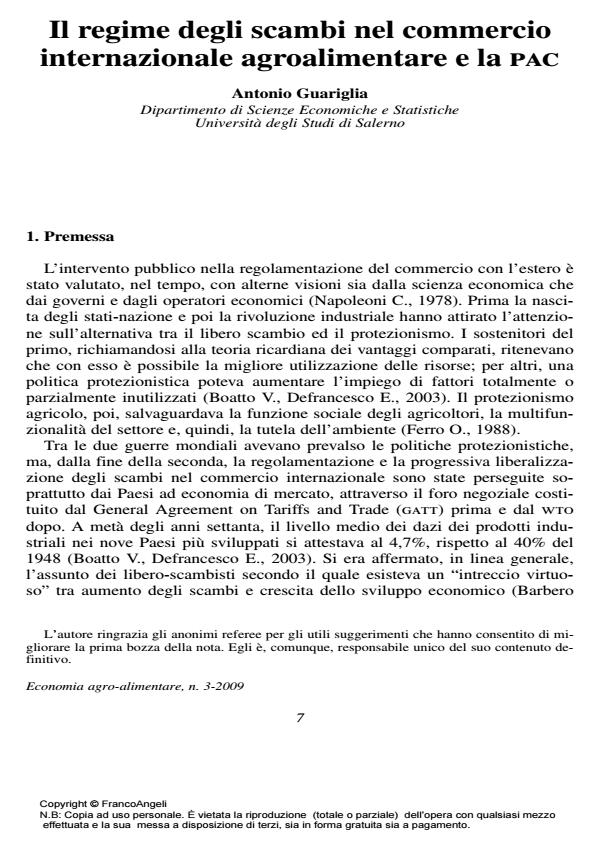Il regime degli scambi nel commercio internazionale agroalimentare e la pac
Journal title ECONOMIA AGRO-ALIMENTARE
Author/s Antonio Guariglia
Publishing Year 2010 Issue 2009/3
Language Italian Pages 22 P. 7-28 File size 324 KB
DOI 10.3280/ECAG2009-003002
DOI is like a bar code for intellectual property: to have more infomation
click here
Below, you can see the article first page
If you want to buy this article in PDF format, you can do it, following the instructions to buy download credits

FrancoAngeli is member of Publishers International Linking Association, Inc (PILA), a not-for-profit association which run the CrossRef service enabling links to and from online scholarly content.
Protectionist policies have prevailed between the two World Wars but, at the end of World War II regulations and progressive liberalisation of international trade have been pursued especially in open market countries through the Agreement on Tariffs and Trade (gatt) first and the wto later. The General Agreement on Tariffs and Trade is an international agreement signed in Geneve by twenty three counties on October 31 1947 and which came into force in January 1948. The main objective of this Agreement was the reduction of tariff barriers to international trade and set the ground for a multilateral system of trade relations aiming to favor international trade liberalisation. The principle the gatt is based on is not that of discrimination in fact it is based upon the most favored nation clause: the conditions applied to the most favored nation (i.e. a nation with fewer restrictions and more trade advantages, such as low tariffs) are applied to all nations with which it has commercial agreements. Another clause of the non discrimination principle is that of "National treatment": imported goods cannot be treated more unfavorably compared to locally produced goods. The gatt has organized eight rounds of multilateral negotiations up to the signature of the last round, the Uruguay round in April 1994 at Marrakech, where among other things the wto was born. In mid-70’s the average tariff barriers of the industrial goods in nine most developed countries was around 4.7% compared to 40% of 1948. In general the freetrade proposition established the virtuous circle between foreign exchange increase and economic development. In fact, between the ’50s and the ’80s the first increased threefold and the second sixfold. In this period the primary sector gave a partial contribution to the international trade increase (annual average 3.5%), as it was a sector caracterized, in almost al countries, by a substantive public intervention and, consequently by a considerable diffusion of non-tariff barriers which constitute some of the most difficult obstacles to overcome in negotiations on trade liberalisation. In the Uruguay Round agriculture played a more relevant role than in the past ever did and the agreements reached were more important for the influence on the subsequent agrarian policies of the various participants than for the effective contribution to the agri-food trade liberalisation. In November 2001 the Fourth wto Ministerial Conference, held in Doha (Qatar), started the negotiations called Doha Round; the final Ministerial Declaration was called Doha Development Agenda (dda) and it states that, within the agricultural negotiations, by March 2003 they should have designed a draft of agreement on the quantification of liberalisation modalities on. Market access, exports subsidies and internal support mechanisms. In the aftermath several negotiations in different places have followed but they didn’t come out to an agreement. In the latest meeting of July 2008 held in Genève to the "historical" conflicts between usa and eu and Developed countries and Developing countries was added the position of Less Developed countries. The principal oppositions, which contributed to prevent a positive conclusion of the negotiation, have occurred among the exporting countries (cairns and G-20 groups), promoters of an easier access to markets by reducing tariffs, and importers (G-33), concerned about defending themselves from an increasing level of imports. Both groups are interested in reducing internal support and the abatement of exports subsidies more from usa than from eu. In fact, the eu has gradually dismantled protectionist mechanisms (transformation into tariffs of non-tariff barriers) and is reducing the internal support (price fixing and coupling of subsidies) and is eliminating exports supports through the Mac Sharry Reform of 1992, the Agenda 2000 of 1999, the Fischler Reform of 2003, the Common Market Organization Reforms of many sectors between 2004 and 2007, the decisions made after the Health Check of 2008. In substance, the changes of the cap have been implemented to counter the problem of surplus in some sectors, to lower excessive costs of price and market policies, in order to spur rural development but also to comply with the requirements of multilateral treaties aiming to liberalise foreign trade. The pretext of the breaking out of the last negotiation has been the proposal of India to introduce the Special Safeguard Mechanism (tariffs increase) to a level of imports increase by 10% against a usa proposal of 40%. The less liberalist positions are not held, as in the past, only by more developed countries but have often found their backing in other countries preoccupied with protecting their agricultural productions on which the economy is still based on. The failure of the Doha Round does not benefit: a) to more competitive developing countries (G-20), as they have got limited commercial preferences and could not increase their exports; b) to the poorest (African Union and G-33), as they would see the problems of insufficient produce; c) to developed countries as they cannot afford a further increase of produce prices over a world recession of which it is difficult to forecast the characteristics and the evolution. For this reason it is needed a resumption of negotiations in order to reach a sufficiently unanimous agreement.
Keywords: Gatt, wto, cap, Doha round, international trade, trade liberalisation, protectionism
Jel codes: F13, Q17, Q18
Antonio Guariglia, Il regime degli scambi nel commercio internazionale agroalimentare e la pac in "ECONOMIA AGRO-ALIMENTARE" 3/2009, pp 7-28, DOI: 10.3280/ECAG2009-003002